Abstract
Two chimaeric human-rat class Alpha glutathione transferases were constructed by fusion of DNA segments derived from the plasmids pTGT2-AT and pGTB38 and expression of the corresponding proteins in Escherichia coli. The recombinant proteins H1R1/1 and H1R1/2 encoded by plasmids pH1R1/1 and pH1R1/2 are composed of a segment of the human class Alpha subunit 1 from the N-terminus to His-143 and Pro-207 respectively, followed by the complementary C-terminal portion of the rat class Alpha subunit 1 sequence. Compared with the parental human enzyme, H1R1/1 is altered in 20 positions due to the introduction of 79 residues from the rat enzyme, while H1R1/2 is altered in five positions out of 15 in the C-terminal region. The design of mutant H1R1/1 is equivalent to introduction of exons 6 and 7 of the rat subunit 1 gene in place of the homologous human nucleotide sequence. The two chimaeric proteins are enzymatically active with several substrates, even though the activity in most cases is somewhat decreased in comparison with the wild-type human enzyme. Inhibition studies show that the kinetic properties mimic those of the human enzyme, indicating that the N-terminal two-thirds of the primary structure plays the major role in governing the catalytic properties. The results of this study demonstrate that recombination of segments of primary structure between homologous enzymes may serve as a useful cassette technique for design of novel catalytically active proteins.
Full text
PDF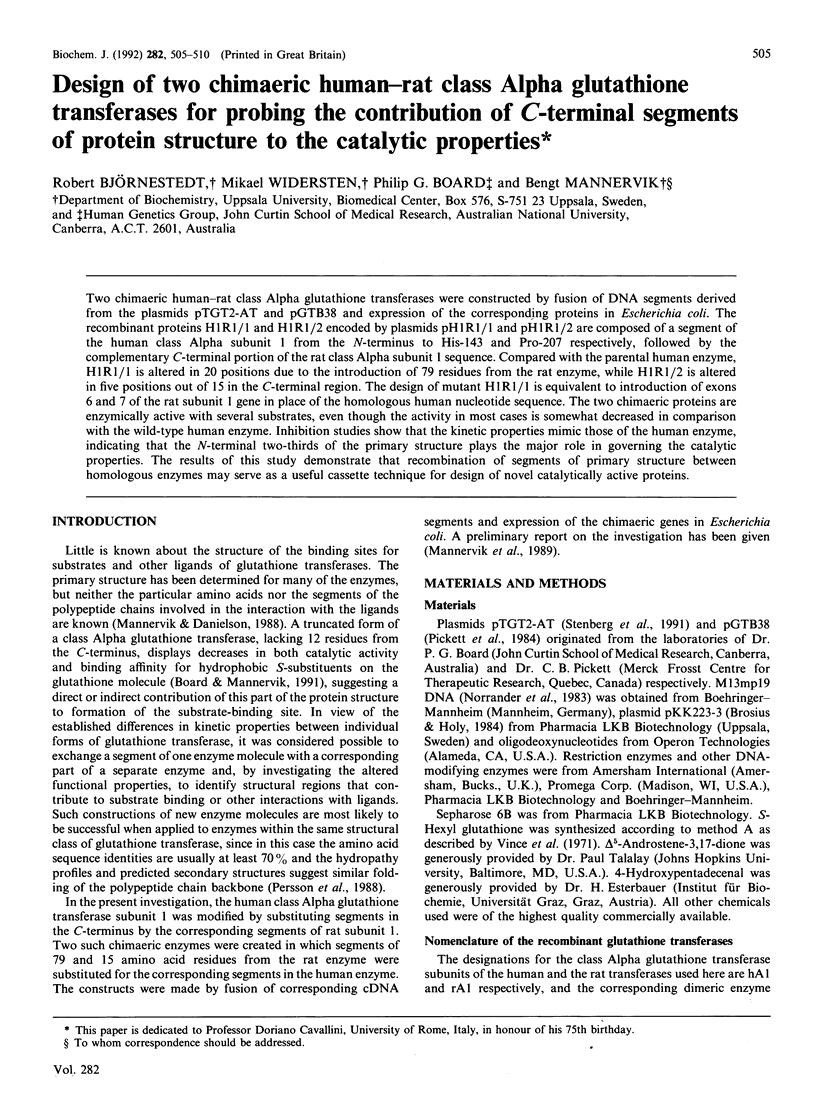
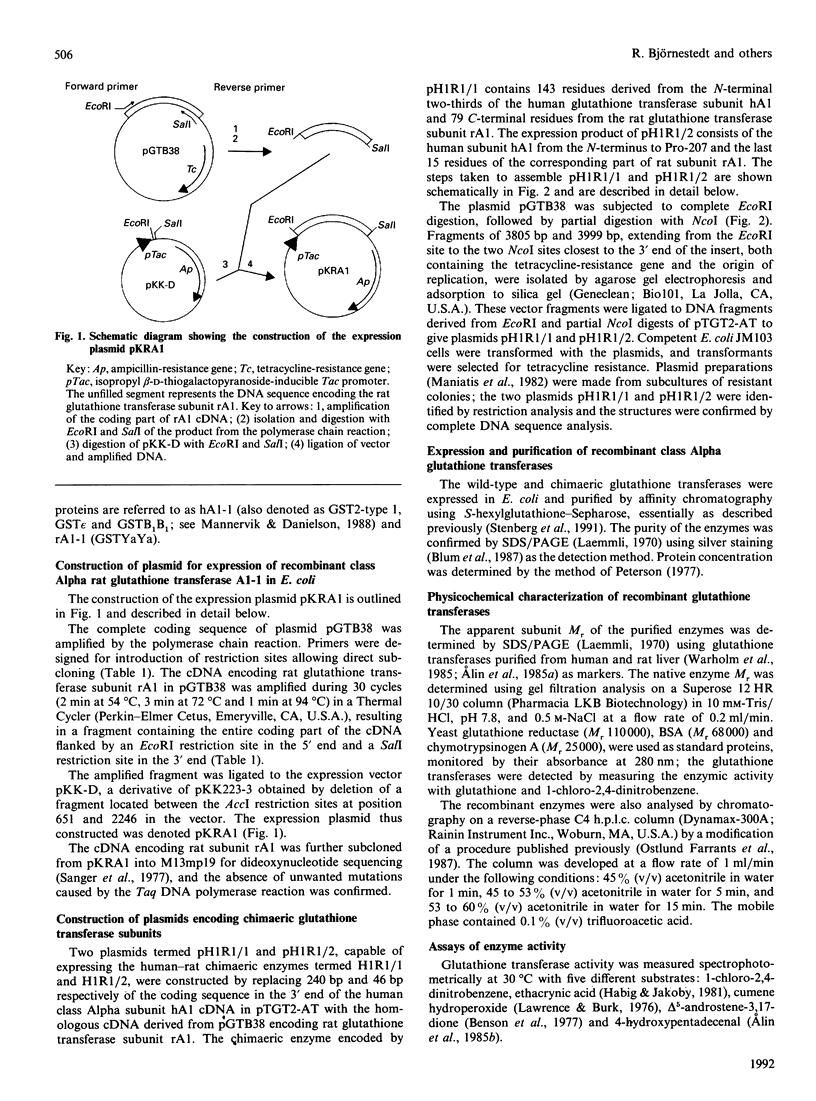
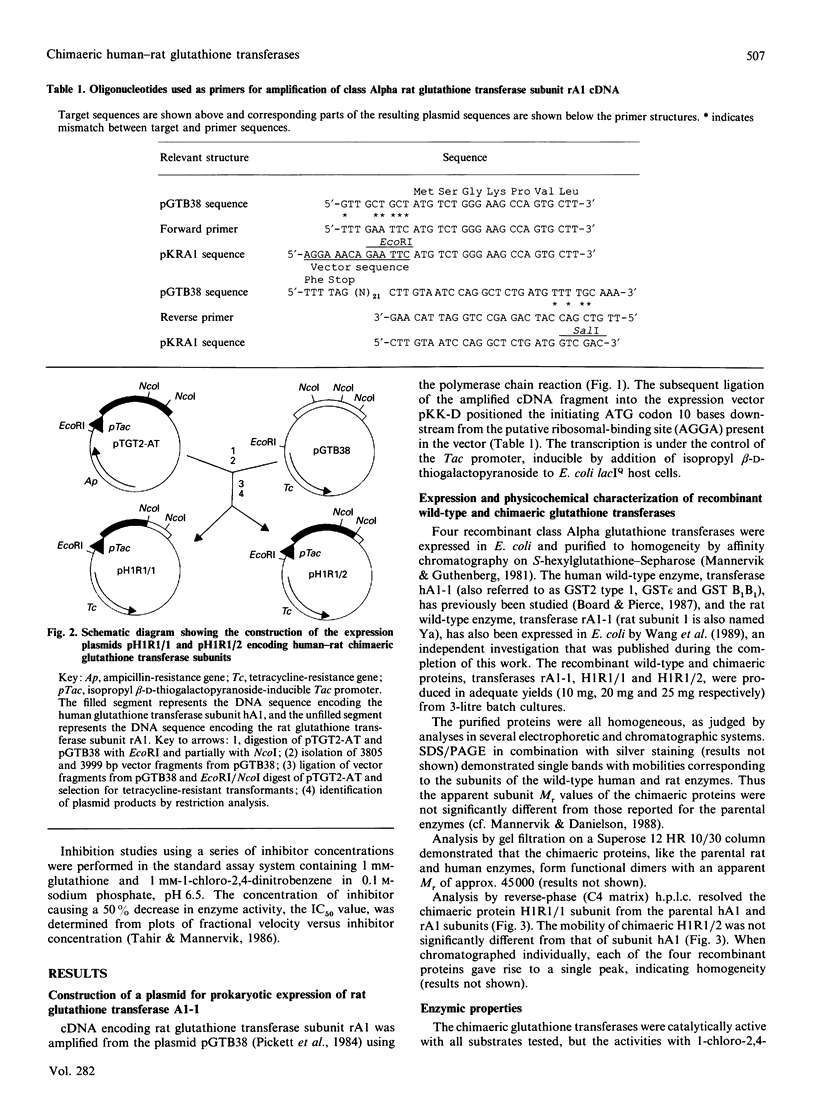
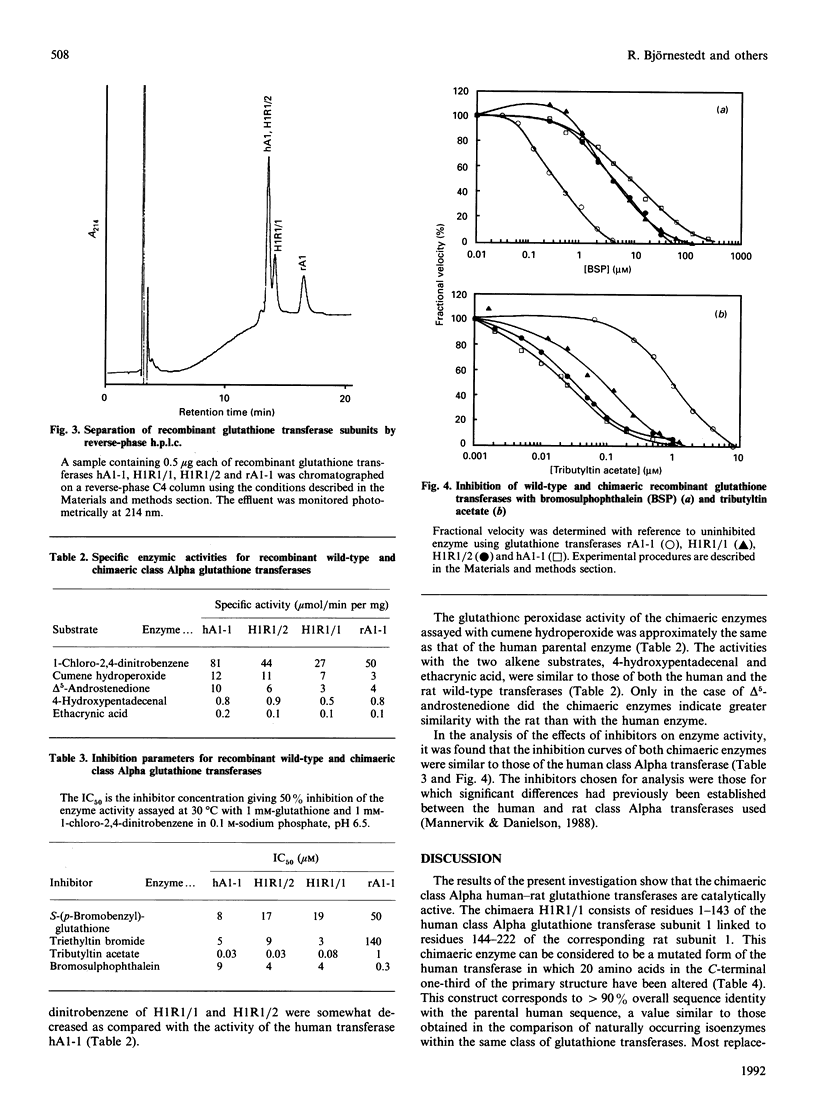
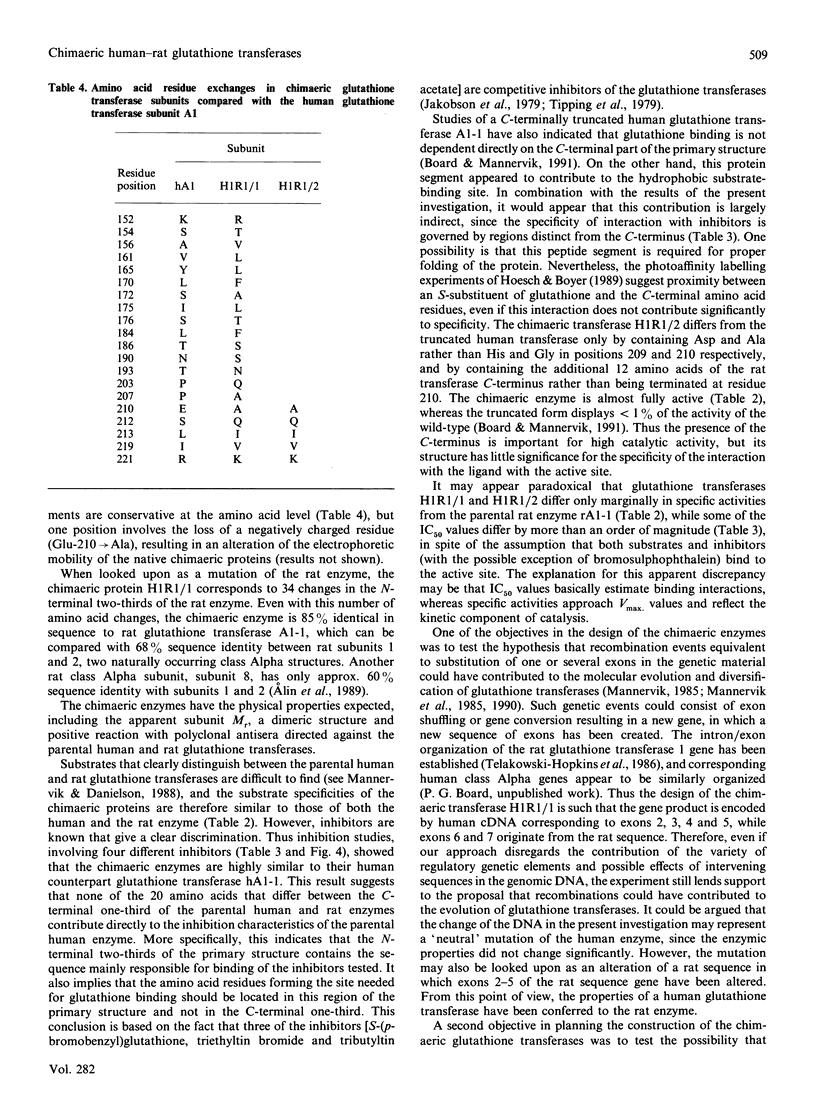

Selected References
These references are in PubMed. This may not be the complete list of references from this article.
- Alin P., Danielson U. H., Mannervik B. 4-Hydroxyalk-2-enals are substrates for glutathione transferase. FEBS Lett. 1985 Jan 7;179(2):267–270. doi: 10.1016/0014-5793(85)80532-9. [DOI] [PubMed] [Google Scholar]
- Alin P., Jensson H., Cederlund E., Jörnvall H., Mannervik B. Cytosolic glutathione transferases from rat liver. Primary structure of class alpha glutathione transferase 8-8 and characterization of low-abundance class Mu glutathione transferases. Biochem J. 1989 Jul 15;261(2):531–539. doi: 10.1042/bj2610531. [DOI] [PMC free article] [PubMed] [Google Scholar]
- Alin P., Jensson H., Guthenberg C., Danielson U. H., Tahir M. K., Mannervik B. Purification of major basic glutathione transferase isoenzymes from rat liver by use of affinity chromatography and fast protein liquid chromatofocusing. Anal Biochem. 1985 May 1;146(2):313–320. doi: 10.1016/0003-2697(85)90545-7. [DOI] [PubMed] [Google Scholar]
- Benson A. M., Talalay P., Keen J. H., Jakoby W. B. Relationship between the soluble glutathione-dependent delta 5-3-ketosteroid isomerase and the glutathione S-transferases of the liver. Proc Natl Acad Sci U S A. 1977 Jan;74(1):158–162. doi: 10.1073/pnas.74.1.158. [DOI] [PMC free article] [PubMed] [Google Scholar]
- Board P. G., Mannervik B. The contribution of the C-terminal sequence to the catalytic activity of GST2, a human alpha-class glutathione transferase. Biochem J. 1991 Apr 1;275(Pt 1):171–174. doi: 10.1042/bj2750171. [DOI] [PMC free article] [PubMed] [Google Scholar]
- Board P. G., Pierce K. Expression of human glutathione S-transferase 2 in Escherichia coli. Immunological comparison with the basic glutathione S-transferases isoenzymes from human liver. Biochem J. 1987 Dec 15;248(3):937–941. doi: 10.1042/bj2480937. [DOI] [PMC free article] [PubMed] [Google Scholar]
- Brosius J., Holy A. Regulation of ribosomal RNA promoters with a synthetic lac operator. Proc Natl Acad Sci U S A. 1984 Nov;81(22):6929–6933. doi: 10.1073/pnas.81.22.6929. [DOI] [PMC free article] [PubMed] [Google Scholar]
- Habig W. H., Jakoby W. B. Assays for differentiation of glutathione S-transferases. Methods Enzymol. 1981;77:398–405. doi: 10.1016/s0076-6879(81)77053-8. [DOI] [PubMed] [Google Scholar]
- Hoesch R. M., Boyer T. D. Localization of a portion of the active site of two rat liver glutathione S-transferases using a photoaffinity label. J Biol Chem. 1989 Oct 25;264(30):17712–17717. [PubMed] [Google Scholar]
- Jakobson I., Warholm M., Mannervik B. The binding of substrates and a product of the enzymatic reaction to glutathione S-transferase A. J Biol Chem. 1979 Aug 10;254(15):7085–7089. [PubMed] [Google Scholar]
- Laemmli U. K. Cleavage of structural proteins during the assembly of the head of bacteriophage T4. Nature. 1970 Aug 15;227(5259):680–685. doi: 10.1038/227680a0. [DOI] [PubMed] [Google Scholar]
- Lawrence R. A., Burk R. F. Glutathione peroxidase activity in selenium-deficient rat liver. Biochem Biophys Res Commun. 1976 Aug 23;71(4):952–958. doi: 10.1016/0006-291x(76)90747-6. [DOI] [PubMed] [Google Scholar]
- Mannervik B., Alin P., Guthenberg C., Jensson H., Tahir M. K., Warholm M., Jörnvall H. Identification of three classes of cytosolic glutathione transferase common to several mammalian species: correlation between structural data and enzymatic properties. Proc Natl Acad Sci U S A. 1985 Nov;82(21):7202–7206. doi: 10.1073/pnas.82.21.7202. [DOI] [PMC free article] [PubMed] [Google Scholar]
- Mannervik B., Danielson U. H. Glutathione transferases--structure and catalytic activity. CRC Crit Rev Biochem. 1988;23(3):283–337. doi: 10.3109/10409238809088226. [DOI] [PubMed] [Google Scholar]
- Mannervik B., Guthenberg C. Glutathione transferase (human placenta). Methods Enzymol. 1981;77:231–235. doi: 10.1016/s0076-6879(81)77030-7. [DOI] [PubMed] [Google Scholar]
- Mannervik B. The isoenzymes of glutathione transferase. Adv Enzymol Relat Areas Mol Biol. 1985;57:357–417. doi: 10.1002/9780470123034.ch5. [DOI] [PubMed] [Google Scholar]
- Norrander J., Kempe T., Messing J. Construction of improved M13 vectors using oligodeoxynucleotide-directed mutagenesis. Gene. 1983 Dec;26(1):101–106. doi: 10.1016/0378-1119(83)90040-9. [DOI] [PubMed] [Google Scholar]
- Ostlund Farrants A. K., Meyer D. J., Coles B., Southan C., Aitken A., Johnson P. J., Ketterer B. The separation of glutathione transferase subunits by using reverse-phase high-pressure liquid chromatography. Biochem J. 1987 Jul 15;245(2):423–428. doi: 10.1042/bj2450423. [DOI] [PMC free article] [PubMed] [Google Scholar]
- Persson B., Jörnvall H., Alin P., Mannervik B. Structural classes of glutathione transferase: distinctions between isoenzymes and enzymes. Protein Seq Data Anal. 1988 Feb;1(3):183–186. [PubMed] [Google Scholar]
- Peterson G. L. A simplification of the protein assay method of Lowry et al. which is more generally applicable. Anal Biochem. 1977 Dec;83(2):346–356. doi: 10.1016/0003-2697(77)90043-4. [DOI] [PubMed] [Google Scholar]
- Pickett C. B., Telakowski-Hopkins C. A., Ding G. J., Argenbright L., Lu A. Y. Rat liver glutathione S-transferases. Complete nucleotide sequence of a glutathione S-transferase mRNA and the regulation of the Ya, Yb, and Yc mRNAs by 3-methylcholanthrene and phenobarbital. J Biol Chem. 1984 Apr 25;259(8):5182–5188. [PubMed] [Google Scholar]
- Sanger F., Nicklen S., Coulson A. R. DNA sequencing with chain-terminating inhibitors. Proc Natl Acad Sci U S A. 1977 Dec;74(12):5463–5467. doi: 10.1073/pnas.74.12.5463. [DOI] [PMC free article] [PubMed] [Google Scholar]
- Stenberg G., Board P. G., Carlberg I., Mannervik B. Effects of directed mutagenesis on conserved arginine residues in a human Class Alpha glutathione transferase. Biochem J. 1991 Mar 1;274(Pt 2):549–555. doi: 10.1042/bj2740549. [DOI] [PMC free article] [PubMed] [Google Scholar]
- Tahir M. K., Mannervik B. Simple inhibition studies for distinction between homodimeric and heterodimeric isoenzymes of glutathione transferase. J Biol Chem. 1986 Jan 25;261(3):1048–1051. [PubMed] [Google Scholar]
- Telakowski-Hopkins C. A., Rothkopf G. S., Pickett C. B. Structural analysis of a rat liver glutathione S-transferase Ya gene. Proc Natl Acad Sci U S A. 1986 Dec;83(24):9393–9397. doi: 10.1073/pnas.83.24.9393. [DOI] [PMC free article] [PubMed] [Google Scholar]
- Tipping E., Ketterer B., Christodoulides L., Elliott B. M., Aldridge W. N., Bridges J. W. The interactions of triethyltin with rat glutathione-S-transferases A, B and C. Enzyme-inhibition and equilibrium-dialysis studies. Chem Biol Interact. 1979 Mar;24(3):317–327. doi: 10.1016/0009-2797(79)90080-2. [DOI] [PubMed] [Google Scholar]
- Vince R., Daluge S., Wadd W. B. Studies on the inhibition of glyoxalase I by S-substituted glutathiones. J Med Chem. 1971 May;14(5):402–404. doi: 10.1021/jm00287a006. [DOI] [PubMed] [Google Scholar]
- Wang R. W., Pickett C. B., Lu A. Y. Expression of a cDNA encoding a rat liver glutathione S-transferase Ya subunit in Escherichia coli. Arch Biochem Biophys. 1989 Mar;269(2):536–543. doi: 10.1016/0003-9861(89)90137-9. [DOI] [PubMed] [Google Scholar]
- Warholm M., Guthenberg C., von Bahr C., Mannervik B. Glutathione transferases from human liver. Methods Enzymol. 1985;113:499–504. doi: 10.1016/s0076-6879(85)13065-x. [DOI] [PubMed] [Google Scholar]
- Zhang P. H., Armstrong R. N. Construction, expression, and preliminary characterization of chimeric class mu glutathione S-transferases with altered catalytic properties. Biopolymers. 1990 Jan;29(1):159–169. doi: 10.1002/bip.360290121. [DOI] [PubMed] [Google Scholar]


